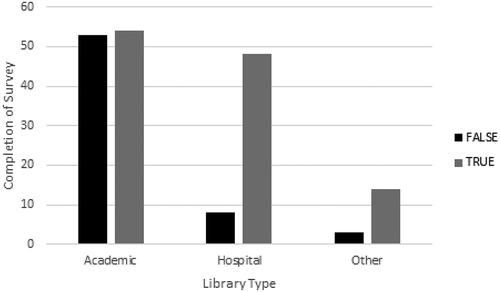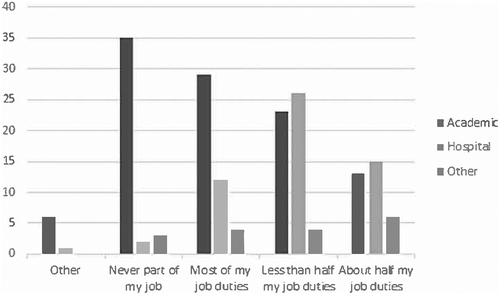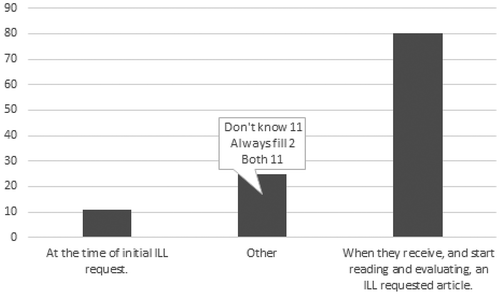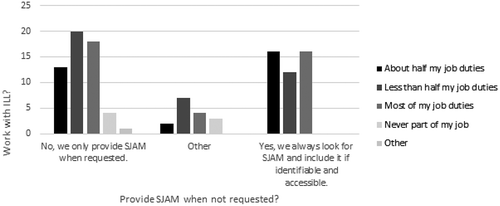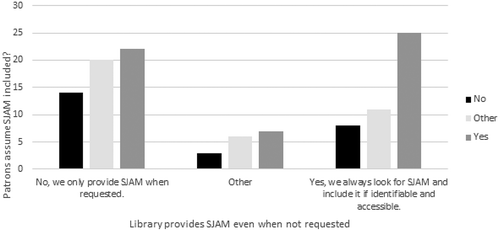ABSTRACT
The use of supplemental journal article materials is increasing in all disciplines. These materials may be datasets, source code, tables/figures, multimedia, or other materials that previously went unpublished, were attached as appendices, or were included within the body of the work. Current emphasis on critical appraisal and reproducibility demands that researchers have access to the complete life cycle to fully evaluate research. As more libraries become dependent on secondary aggregators and interlibrary loan, we questioned if access to these materials is equitable and sustainable. While NISO RP-15-2013 Recommended Practices for Online Supplemental Journal Article Materials was published in 2013, it is unclear if these recommended practices fully meet the needs of users; if aggregators and publishers are following these standards; and if library processes and procedures are facilitating access to supplemental journal article materials. While studies have surveyed authors, reviewers, and readers, or examined journal supplemental materials practices, no studies have surveyed library staff and librarians about their experience with access to supplemental materials and requesting and receiving supplemental materials through interlibrary loan. This presentation reported on a study surveying library employees from academic, hospital, public and special library settings in the United States about their experiences identifying, finding, and retrieving supplemental journal article materials; and proposes ways that libraries, publishers and aggregators can enable access to the complete published life cycle.
Introduction
Supplemental journal article materials (SJAM) support efforts to reproduce research, to make data accessible and transparent for further research, and to trace the impact of research. Librarians and library staff may confuse journal supplements with SJAM. They differ widely in that journal supplements contain original articles or conference abstracts not found elsewhere, while SJAM, supplementary materials, supplemental information (SI) or additional files, may consist of tables and figures, checklists, flow diagrams, interview transcripts, data, software codes, visualizations, methods, media files, reagents, dynamic models, and other materials found outside the article.Footnote1 Supplemental journal article materials are a new and growing phenomenon brought on first by the onset of electronic publishing and article length restrictions, and more recently by the demand for critical appraisal, reproducibility/transparency of research, and funder open data policies.Footnote2
Recognizing growing problems with SJAM, the National Information Standards Organization (NISO) and the National Federation of Advanced Information Services (NFAIS) created RP-15-2013 Recommended Practices for Online Supplemental Journal Article Materials in 2013.Footnote3 This document distinguishes two functional categories of SJAM, integral content essential for understanding of the work and additional content that expands reader understanding but is not essential. Recommendations include 1) publishers should provide written guidelines for acceptance or outsource archiving of SJAM, 2) SJAM should be reviewed at the same level as the article, 3) SJAM should have a persistent identifier, 4) SJAM should have standardized naming conventions, metadata including file types, indexing in databases, and navigation in the table of contents and article, and 5) bibliographic references within SJAM should be treated differently based on designation of the SJAM as integral or additional. Some feel that current recommended practices do not go far enough in defining standard terminology and how SJAM should be organized, formatted and indexed.Footnote4
Despite these recommended practices, this study stems from requests that librarians and library staff continue to receive from research faculty and clinicians, or observe in library listservs, looking for SJAM. These requests come to a variety of liaison, reference, systems, access services, and interlibrary loan librarians and library staff, and often go undocumented and uncollected. As well, we are anecdotally aware that libraries do not understand the full extent of the problem as many researchers bypass libraries altogether and turn to colleagues when unable to access SJAM. In many respects libraries and research communities are having separate parallel conversations about supplemental materials, each centered around their own siloed practices.
Journals currently lack consistent policies on SJAM.Footnote5 Some journals may request that SJAM be submitted as one file while other journals require that they be submitted separately and tied to elements of the article, and yet others do not allow submission of any SJAM.Footnote6 As the reproducibility movement expands and awareness of FAIR (findability, accessibility, interoperability, reusability) principles grows, individual journals and professional organizations have published best practices for SJAM. Alter and Gonzalez recommend that data be deposited in domain-specific repositories, with a separate and unique identity, and associated with publications through citation.Footnote7 However, this best practice does not take into account the variety of integral materials submitted as SJAM, nor does it account for reader frustrations with link rot.Footnote8 Surveys of authors, readers, and reviewers show a preference for publication of SJAM on the journal website.Footnote9 Since journals have not traditionally viewed SJAM as stand-alone items, continuation of this practice comes with recommendations for structure, standards, internal navigation and micro-digital object identifiers for specific sections of a paper.Footnote10
Historical dependence on the Portable Document Format (PDF) is shifting as researchers recognize value in reusable, interactive and machine-readable file types.Footnote11 Despite Kenyon’s finding in 2016 that disciplines continue to share data primarily as Word files or PDF documents on journal websites, a growing number of disciplines now depend on high-throughput methods where access to SJAM in formats that facilitate data mining tools is imperative to use.Footnote12 This more recent need for machine-readable data may be one reason why some authors suggest that data be deposited in domain-specific repositories, instead of journal websites or institutional repositories, because curation, metadata application services, and supported file types are robust and consistent with disciplinary expectations.Footnote13
Library systems like interlibrary loan (ILL) are also structured around the PDF. While the ALA Interlibrary Loan Code for the United States has undergone slight revisions over time, it does not address SJAM.Footnote14 It is merely a voluntary code of behavior for lending and requesting libraries and it is not enforced by any oversight body. Similarly, International Federation of Library Associations and Institutions (IFLA) Guidelines for Best Practice in Interlibrary Loan and Document Delivery and International Resource Sharing and Document Delivery: Principles and Guidelines for Procedure, 2009 revision make no mention of SJAM.Footnote15
Many historical complaints about SJAM can be traced to non-indexing.Footnote16 This may stem from some of the more heavily used scholarly search engines, PubMed and Google Scholar not indicating the presence of SJAM. While ours is not meant to be a study of indexing and abstracting services, a cursory look reveals that many library databases also do not index SJAM. An exception may be Web of Science where limited associated data are displayed through the connection with Data Citation Index. On the other hand, some Open Access repositories are rapidly adopting consistent user interfaces for identification of SJAM. PubMed Central (PMC) has a requirement that all SJAM be supplied with articles submitted to PMC, even when they are available in a public repository, and designated with unique identifiers and associated Extensible Markup Language (XML).Footnote17 The arXiv pre-print servers also identify the presence of supplementary material and data/code.
While previous authors have surveyed authors and reviewers or evaluated SJAM practices and adherence to standards in disciplinary publications, these studies rarely trickle down to the level of library employees working to identify and access SJAM on a daily basis.Footnote18 No studies have interviewed librarians and library staff about their collective experience with SJAM. Greater understanding of access to SJAM is needed as more libraries obtain journal articles from secondary aggregators and through ILL. This study aims to understand librarians and library staff members experience with SJAM, and provide recommendations for identifying, finding and retrieving SJAM.
Methods
The survey was formed and validated by two librarians and a library access services manager. We chose a mixed method survey design using Qualtrics. Quantitative questions were chosen to get an overview of librarian and library staff demographics, library types, what subject areas were requesting these materials and where the SJAM’s become bottlenecked. We provided several open-ended questions to understand difficulties of acquiring supplemental materials, knowledge of NISO guidelines around SJAM and frequency of library workers’ interaction with SJAM based on ILL requests.
Qualitative and quantitative data were collected, analyzed separately, and integrated to inform the final discussion. Survey distribution was aimed to reach a wide variety of library workers, including library staff and librarians that may work daily with ILL or encounter SJAM peripherally through requests from faculty. We also sought to find a variety of types of libraries. After Institutional Review Board (IRB) exemption was received, the survey was distributed to listservs for academic, special and medical librarians and library staff who fulfill ILL and have access services roles. The survey was sent twice over a two-week period in July 2019.
Quantitative demographic data were compiled, and descriptive statistical comparisons were run in Excel Pivot tables. For qualitative analysis, open-ended responses were coded and analyzed by librarians based on grounded theory. Grounded theory uses constant comparative analysis to identify common themes and categories emerging from rich descriptive data.Footnote19 For inter-rater reliability, responses were coded separately by the authors and exchanged for verification.
Results
Of the 21,451 members of listservs to which the survey was distributed, 211 opened the survey. This is a 1% response rate, although many individuals subscribe to multiple listservs. A total of 197 answered the question about U.S. residency and 191 indicated they live in the United States as required by our IRB ().
Table 1. Participant demographics
Average time to completion was 21 min. Respondents work in academic (56%), hospital (29%) and other special libraries (9% – government, publisher, institute, and organization). None work in public libraries and 6% did not respond. While hospital librarians made up a smaller percent of survey respondents, they were more likely to complete the entire survey. () A total of 120 answered at least one question specifically about SJAM. The average library size within limitations of the survey was 11,457 potential users, with a range of 50 to 200,000.
Quantitative
While access to SJAM is not only relevant to those librarians and library staff members working with ILL, we know that questions about SJAM frequently come up in the context of ILL and thus, several survey questions asked specifically about ILL. In comparing how much responders work with ILL (Q3 N = 179) by library type () it was apparent that ILL usually makes up at least part of hospital library work, while academic library responders were more likely to respond that it was either never a part of their work or most of their job duty.
When asked about frequency of ILL requests for SJAM (Q4 N = 119), 85% of respondents affirmed that patrons request supplemental materials, with 31% indicating more than ten requests a year. Requests for supplemental materials come to all respondents regardless of their level of involvement with interlibrary loan, though those who described their job as mostly with ILL receive the most requests for SJAM. ()
When asked at what point patrons are aware of SJAM in an ILL request (Q9 N = 116), of those that replied 69% felt that requesters were not aware of SJAM until after they received the article, 9% felt that they were aware prior to making an initial ILL request, and 22% said they do not know or a combination of before and after the request. ()
Forty-seven percent of respondents say patrons assume that SJAM will be included without asking for it (Q10 N = 116), 22% do not believe that patrons assume it will be provided without asking, and 32% said other. Of those who replied other, most don’t know (N = 19) and others replied sometimes (N = 12) or that they always provide it (N = 1).
When asked if their institution provides SJAM even when not requested when filling ILL requests (Q11 N = 116 ), respondents fall into four categories. Nearly half (48%) only provide SJAM if it is asked for, 38% always look for and provide SJAM if accessible, and 8% replied other which included responses like if aware, if easy and that they always provide only with DOCLINE requests. Recall though that at this point in the survey over a third of the initial respondents did not answer the questions about SJAM. This results in a fourth category and we might assume that those who did not respond to this question do not know what their institution does in regard to SJAM based on qualitative responses.
More work with ILL (Q3) was not associated with any greater tendency to look for and provide SJAM (Q11 N = 116). ()
Most telling are correlations between Q10 (Do patrons assume that SJAM will be included without asking for it?) and Q11 (Do you look for and provide SJAM even when not asked for?). While over 40% replied that patrons assume SJAM will be provided without asking, 47% (N = 22) of those who responded that patrons assume SJAM will be provided are not actually providing SJAM ( N = 116) unless it is requested. We purposely surveyed both librarians and library staff to include perspective of both those who may be involved in setting institutional policy and those who work within policy set by others. Thus, there are apparent gaps and inconsistencies between what we feel patrons assume we do, what library policies state that we do, and what we actually do, and librarians and library staff are aware that we are not always meeting patron expectation.
When asked if patrons put in a second request because they did not receive SJAM (Q12 N = 114), a majority of those who responded say they rarely submit a second ILL request and acknowledge that institutions usually handle the need to track down SJAM through e-mail, which goes unrecorded in ILL statistics. Some responders noted that they have identified those ILL providers that never supply SJAM and removed them from their routing lists.
Qualitative themes () were gleaned from open-ended responses to Q7, 8, 9, 12, and 13.
Table 2. Themes from responses to open-ended questions
Limitations of the study
In Q7 we asked specifically about experience with compliance of specific publishers and aggregators to SJAM standards. There were certain aggregators and publishers mentioned by multiple responders as not complying. This potentially impacts both local patrons and ILL. While open-ended replies to this question suggest that participants anecdotally experience more problems with access through secondary aggregators, we did not ask this question in such a way that it allows direct comparison with access to SJAM in general.
Questions about SJAM are presented to librarians and library staff in a variety of positions, not only to those who work with ILL. As liaison librarians, we know that patrons contact different people at different times when the library is not meeting their needs, or they may not contact the library at all. We purposely sought to include perspectives of both those library employees involved in setting institutional policy and those who work within policy set by others. As part of our purpose in the survey was to identify who receives questions about supplementary material, we did not identify a target population and pilot our survey in advance. However, this exploratory approach did allow us to see that librarians and library staff working in hospital settings when taken as a whole are more aware of patrons’ needs for SJAM and issues with access than academic librarians and library staff as a whole. We also found that more library employees feel that patrons assume that SJAM will be included in an ILL request without it being requested, than are actually supplying SJAM without it being requested.
However, we acknowledge that piloting the survey would have helped us to word questions in a way that made them more consistently understood by a broader audience. For instance, we left the question about library size open-ended. In hindsight, this should have been a multiple-choice question with stated standard units of potential number of institutional library users, as it was interpreted in various ways by responders. Also, we asked several questions that were not fully dichotomous yes/no questions, instead adding an other category. These provided qualitative data (such as only providing SJAM for DOCLINE requests); however, they hindered ability to perform statistical analysis.
Discussion
Requests for access to SJAM are often presented to librarians, and particularly to library staff members, in the form of ILL requests. Our study’s qualitative data confirmed the findings in Price et al. that librarians and library staff prefer that SJAM come in a standardized single zipped file for downloading or as a persistent link to a PDF file.Footnote20 While this fits well with existing library systems, it does not consider the breadth of interactive data and visualization necessary for current scholarly activity and learning.
Based on our results we recommend the following:
Publishers, aggregators, databases, repositories and scholarly search engines should:
Comply with all NISO recommended practices for SJAM, including fixing broken links.
Provide SJAM in one file or as a permanent link with a digital object identifier (DOI).
Index SJAM consistently in a way that facilitates discovery of SJAM without reading the article.
Assure that the industry develops a collective understanding of data as a stand-alone item, increasingly not intended to be linked with one study.
Use consistent/standard terminology, organization, file formats, and systems of reporting SJAM access problems.
Library ILL system vendors should:
Have a way to communicate to the ILL patron that the library checked for supplemental materials, and a way to designate if it was unavailable.
Create ILL systems that are not PDF-dependent and can accommodate the variety of file types made available by publishers (HTML, etc.).
Librarians and library staff should:
Understand how important SJAM is to critical appraisal of research.
Adopt a standard practice of supplying SJAM even when not requested.
Train academic library staff to identify the presence of SJAM using database indexing.
Communicate effectively with patrons about library policies on providing SJAM and instruct patrons on how to best access SJAM.
Understand that data are increasingly separate for a reason. Data are no longer associated with just one article. It is an entity in and of itself.
Patrons and library liaisons who teach patrons should:
Stay current on new journal and database indexing and interface features used to identify the presence of SJAM.
Learn to always look for and request SJAM through ILL.
Standards should:
Provide guidance for consistent access to expanding file formats and linked data.
Discontinue the distinction between integral and additional content as that can only be determined by the reader.
Provide short plain language summaries and infographic visualization of standards for training of library technical staff.
Future studies are needed on how publishers, aggregators, catalogers, databases and library systems can better accommodate a growing amount of linked data and materials. Librarians and library staff members should be trained to ensure that patrons have access to the full research life cycle for reproducibility and critical appraisal purposes. As well, outcomes-based behavior studies are needed to know if patrons and library staff members filling ILL requests are actively looking for, finding, and providing SJAM through library provided systems and subscriptions.
Disclosure statement
No potential conflict of interest was reported by the authors.
Additional information
Notes on contributors
Suzanne Fricke
Suzanne Fricke is Animal Health Sciences Librarian, Washington State University Libraries, Pullman, WA.
Electra Enslow
Electra Enslow is Assistant Director of Clinical Research and Data Services, University of Washington Health Sciences Library, Seattle, WA.
Susan Shipman
Sue Shipman is Access Services Manager, Washington State University Libraries, Pullman, WA.
Notes
1 Ángel Borrego and Francesc Garcia, “Provision of Supplementary Materials in Library and Information Science Scholarly Journals,” Aslib Proceedings 65, no. 5 (2013): 503-14, doi: 10.1108/AP-10-2012-0083; John P. Kastelic and Fulvio Gandolfi, “On-Line Publication of Supplementary Material,” Theriogenology 72, no. 1 (2009): 1, doi: 10.1016/j.theriogenology.2009.04.001; Lior Pachter, “Stories from the Supplement” (keynote address, Genome Informatics 2013, Cold Spring Harbor Laboratory, NY, November 2, 2013), YouTube video, 46:39, uploaded November 4, 2013, accessed April 23, 2020, https://youtu.be/5NiFibnbE8o; Jeremy Kenyon, Nancy Sprague, and Edward Flathers, “The Journal Article as a Means to Share Data: A Content Analysis of Supplementary Materials from Two Disciplines,” Journal of Librarianship & Scholarly Communication 4 (2016): 1-17, doi: 10.7710/2162-3309.2112; Todd Carpenter, “Outside the Core: Working Towards an Industry Recommended Practice for Supplemental Journal Materials,” Serials 23, no. 2 (2010): 155-58, doi: 10.1629/23155; Thomas Schaffer and Kathy M. Jackson, “The Use of Online Supplementary Material in High-Impact Scientific Journals,” Science & Technology Libraries 25, no. 1-2 (2004): 73-85, doi: 10.1300/J122v25n01_06.
2 Ibid.; Carpenter, “Outside the Core.”; Jeremy Kenyon and Nancy R. Sprague, “Trends in the Use of Supplementary Materials in Environmental Science Journals,” Issues in Science & Technology Librarianship 75 (2014): 7, doi: 10.5062/F40Z717Z; National Information Standards Organization and National Federation of Advanced Information Services, NISO RP-15-2013. Recommended Practices for Online Supplemental Journal Article Materials (NISO, January 2013), https://www.niso.org/publications/niso-rp-15-2013-recommended-practices-online-supplemental-journal-article-materials (accessed April 23, 2020).
3 Ibid.
4 Barbara Cheifet, “Making Supplemental Information More Accessible,” Genome Biology 19, no. 1 (2018): 225, doi: 10.1186/s13059-018-1609-8.
5 Mihai Pop and Steven L. Salzberg, “Use and Mis-Use of Supplementary Material in Science Publications,” BMC Bioinformatics 16 (2015): 237, doi: 10.1186/s12859-015-0668-z.
6 American Association for the Advancement of Science, “Science: Information for Authors,” Science, https://www.sciencemag.org/authors/science-information-authors (accessed April 25, 2020); American Society for Microbiology, “mBio Instructions to Authors,” 2019, https://mbio.asm.org/sites/default/files/additional-assets/mbio-ITA.pdf (accessed April 25, 2020); Cell Press, “Supplemental Information Guidelines,” https://www.cell.com/supplemental-information (accessed April 25, 2020); Nature, “On Supplementary Information: Nature Immunology is Implementing New Editorial Guidelines for the Supplementary Material of Research Articles,” Nature Immunology 13, no. 6 (2012): 519, doi: 10.1038/ni.2325; John Maunsell, “Announcement Regarding Supplemental Material,” The Journal of Neuroscience 30, no. 32 (2010): 10599-600, https://www.jneurosci.org/content/30/32/10599 (accessed April 25, 2020).
7 Dov Greenbaum et al., “Structuring Supplemental Materials in Support of Reproducibility,” Genome Biology 18, no. 1 (2017): 64, doi: 10.1186/s13059-017-1205-3; Maunsell, “Announcement Regarding Supplemental Material”; George Alter and Richard Gonzalez, “Responsible Practices for Data Sharing,” The American Psychologist 73, no. 2 (2018): 146-156, doi: 10.1037/amp0000258.
8 Evangelos Evangelou, Thomas A Trikalinos, and John PA Ioannidis, “Unavailability of Online Supplementary Scientific Information from Articles Published in Major Journals,” The FASEB Journal 19, no. 14 (2005): 1943-44, doi: 10.1096/fj.05-4784lsf; Nicholas R. Anderson, Peter Tarczy-Hornoch, and Roger E. Bumgarner, “On the Persistence of Supplementary Resources in Biomedical Publications,” BMC Bioinformatics 7 (2006): 260, doi: 10.1186/1471-2105-7-260.
9 Amy Price et al., “Role of Supplementary Material in Biomedical Journal Articles: Surveys of Authors, Reviewers and Readers,” BMJ Open 8, no. 9 (2018): e021753, doi: 10.1136/bmjopen-2018-021753.
10 Greenbaum et al., “Structuring Supplemental Materials in Support of Reproducibility.”
11 Pop and Salzberg, “Use and Mis-Use of Supplementary Material in Science Publications.”
12 Kenyon, Sprague, and Flathers, “The Journal Article as a Means to Share Data.”; Antonio Jimeno Yepes and Karin Verspoor, “Literature Mining of Genetic Variants for Curation: Quantifying the Importance of Supplementary Material,” Database 2014, (2014), doi: 10.1093/database/bau003.
13 Alter and Gonzalez, “Responsible Practices for Data Sharing.”
14 Codes, Guidelines, and Technical Standards Committee, Sharing and Transforming Access to Resources Section (STARS), “Interlibrary Loan Code for the United States,” American Library Association, Reference and User Services Association, January 11, 2016, http://www.ala.org/rusa/guidelines/interlibrary (accessed April 25, 2020).
15 International Federation of Library Associations and Institutions, Guidelines for Best Practice in Interlibrary Loan and Document Delivery, https://www.ifla.org/publications/guidelines-for-best-practice-in-interlibrary-loan-and-document-delivery (accessed April 23, 2020); International Federation of Library Associations and Institutions, International Resource Sharing and Document Delivery: Principles and Guidelines for Procedure, 2009, https://www.ifla.org/publications/international-resource-sharing-and-document-delivery-principles-and-guidelines-for-proc (accessed April 23, 2020).
16 Frank Seeber, “Citations in Supplementary Information are Invisible,” Nature 451, no. 7181 (2008): 887, doi: 10.1038/451887d; Pop and Salzberg, “Use and Mis-Use of Supplementary Material in Science Publications.”
17 National Library of Medicine, “Associated Data in PMC,” NLM Technical Bulletin, no. 425 (November-December 2018): b4, https://www.nlm.nih.gov/pubs/techbull/nd18/brief/nd18_associated_data_pmc.html (accessed April 23, 2020); Price et al., “Role of Supplementary Material in Biomedical Journal Articles.” Evangelou, Trikalinos, and Ioannidis, “Unavailability of Online Supplementary Scientific Information.”
18 Schaffer and Jackson, “The Use of Online Supplementary Material in High-Impact Scientific Journals.”; Kenyon and Sprague, “Trends in the Use of Supplementary Materials in Environmental Science Journals.”; David L. Schriger et al., “Use of the Internet by Print Medical Journals in 2003 to 2009: A Longitudinal Observational Study,” Annals of Emergency Medicine 57, no. 2 (2011): 153-60.e3, doi: 10.1016/j.annemergmed.2010.10.008; Dave Shutler and Ashley Murray, “Trends, Costs, Benefits, Challenges, and Prognoses for Supplementary Materials,” The Auk 133, no. 4 (2016): 733-37, doi: 10.1642/AUK-16-92.1; Antonio Vidal-Infer et al., “The Availability of Raw Data in Substance Abuse Scientific Journals,” Journal of Substance Use 24, no. 1 (2019): 36-40, doi: 10.1080/14659891.2018.1489905; Sarah C. Williams, “Practices, Policies, and Persistence: A Study of Supplementary Materials in Crop Science Journals,” Journal of Agricultural & Food Information 17, no. 1 (2016): 11-22, doi: 10.1080/10496505.2015.1120213.
19 Antony Bryant and Kathy Charmaz, eds., The SAGE Handbook of Current Developments in Grounded Theory (London: SAGE Publications, 2019).
20 Price et al., “Role of Supplementary Material in Biomedical Journal Articles.”

